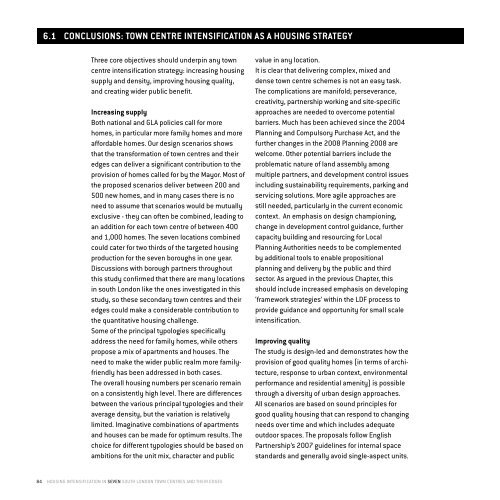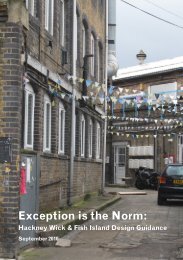Lessons Learnt - Design for London
Lessons Learnt - Design for London
Lessons Learnt - Design for London
You also want an ePaper? Increase the reach of your titles
YUMPU automatically turns print PDFs into web optimized ePapers that Google loves.
6.1 concLusions: town centre intensification as a Housing strategy<br />
Three core o jectives should underpin ny town<br />
centre intensific tion str tegy: incre sing housing<br />
supply nd density, improving housing qu lity,<br />
nd cre ting wider pu lic enefit.<br />
increasing supply<br />
Both n tion l nd GLA policies c ll <strong>for</strong> more<br />
homes, in p rticul r more f mily homes nd more<br />
f<strong>for</strong>d le homes. Our design scen rios shows<br />
th t the tr ns<strong>for</strong>m tion of town centres nd their<br />
edges c n deliver signific nt contri ution to the<br />
provision of homes c lled <strong>for</strong> y the M yor. Most of<br />
the proposed scen rios deliver etween 200 nd<br />
500 new homes, nd in m ny c ses there is no<br />
need to ssume th t scen rios would e mutu lly<br />
exclusive - they c n often e com ined, le ding to<br />
n ddition <strong>for</strong> e ch town centre of etween 400<br />
nd 1,000 homes. The seven loc tions com ined<br />
could c ter <strong>for</strong> two thirds of the t rgeted housing<br />
production <strong>for</strong> the seven oroughs in one ye r.<br />
Discussions with orough p rtners throughout<br />
this study confirmed th t there re m ny loc tions<br />
in south <strong>London</strong> like the ones investig ted in this<br />
study, so these second ry town centres nd their<br />
edges could m ke consider le contri ution to<br />
the qu ntit tive housing ch llenge.<br />
Some of the princip l typologies specific lly<br />
ddress the need <strong>for</strong> f mily homes, while others<br />
propose mix of p rtments nd houses. The<br />
need to m ke the wider pu lic re lm more f milyfriendly<br />
h s een ddressed in oth c ses.<br />
The over ll housing num ers per scen rio rem in<br />
on consistently high level. There re differences<br />
etween the v rious princip l typologies nd their<br />
ver ge density, ut the v ri tion is rel tively<br />
limited. Im gin tive com in tions of p rtments<br />
nd houses c n e m de <strong>for</strong> optimum results. The<br />
choice <strong>for</strong> different typologies should e sed on<br />
m itions <strong>for</strong> the unit mix, ch r cter nd pu lic<br />
84 HOUSING INTENSIfICATION IN SEVEN SOUTH LONDON TOWN CENTRES AND THEIR EDGES<br />
v lue in ny loc tion.<br />
It is cle r th t delivering complex, mixed nd<br />
dense town centre schemes is not n e sy t sk.<br />
The complic tions re m nifold; persever nce,<br />
cre tivity, p rtnership working nd site-specific<br />
ppro ches re needed to overcome potenti l<br />
rriers. Much h s een chieved since the 2004<br />
Pl nning nd Compulsory Purch se Act, nd the<br />
further ch nges in the 2008 Pl nning 2008 re<br />
welcome. Other potenti l rriers include the<br />
pro lem tic n ture of l nd ssem ly mong<br />
multiple p rtners, nd development control issues<br />
including sust in ility requirements, p rking nd<br />
servicing solutions. More gile ppro ches re<br />
still needed, p rticul rly in the current economic<br />
context. An emph sis on design ch mpioning,<br />
ch nge in development control guid nce, further<br />
c p city uilding nd resourcing <strong>for</strong> Loc l<br />
Pl nning Authorities needs to e complemented<br />
y ddition l tools to en le proposition l<br />
pl nning nd delivery y the pu lic nd third<br />
sector. As rgued in the previous Ch pter, this<br />
should include incre sed emph sis on developing<br />
‘fr mework str tegies’ within the LDf process to<br />
provide guid nce nd opportunity <strong>for</strong> sm ll sc le<br />
intensific tion.<br />
improving quality<br />
The study is design-led nd demonstr tes how the<br />
provision of good qu lity homes (in terms of rchitecture,<br />
response to ur n context, environment l<br />
per<strong>for</strong>m nce nd residenti l menity) is possi le<br />
through diversity of ur n design ppro ches.<br />
All scen rios re sed on sound principles <strong>for</strong><br />
good qu lity housing th t c n respond to ch nging<br />
needs over time nd which includes dequ te<br />
outdoor sp ces. The propos ls follow English<br />
P rtnership’s 2007 guidelines <strong>for</strong> intern l sp ce<br />
st nd rds nd gener lly void single- spect units.





